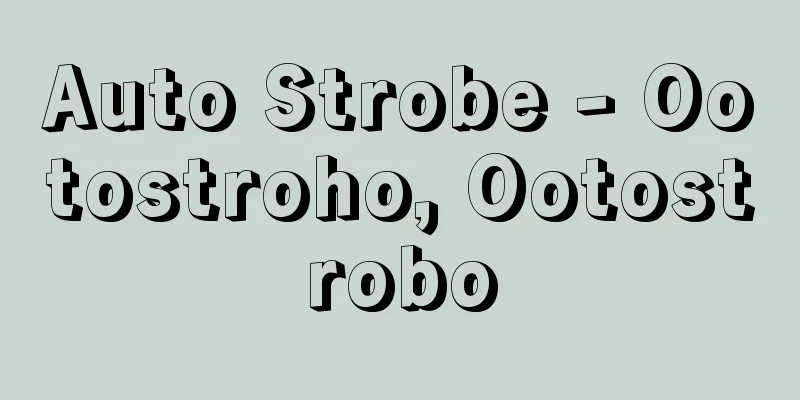Drawing - Seizu (English)

|
Drawings are created that accurately and effectively depict the shape and size of an item in order to manufacture it. Drawings must be complete, accurate, and clear so that the correct product can be obtained by processing it as instructed, and there is no room for different interpretations depending on the viewer. Products include all kinds of industrial products, and the methods of drawing them, or drafting methods, vary depending on the particular characteristics of each, including mechanical drawing, civil engineering drawing, architectural drawing, electrical drawing, chemical drawing, and clothing drawing. This article will focus on mechanical drawing. [Kiyoshi Onishi] History of DraftingHumans have been using paintings and drawings since prehistoric times. Murals and reliefs can be seen on the walls of tombs, temples, and royal palaces dating back thousands of years before Christ, and it is easy to imagine that similar paintings and drawings were used in civil engineering construction projects at the time. The Greek Heron's Baroulkos Mecanica, written around the 2nd century B.C., contains illustrations of numerous mechanical devices, making it a valuable resource for learning about the technology of the time. However, since free men in the Greek era were only engaged in thought, and labor using the hands and feet was left to slaves, it is doubtful that these ideas and diagrams were actually used to build machines. Archimedes, for example, invented many things, including the famous screw water pump, but he never tried to put them to practical use. In the Middle Ages, a major step forward from the conventional pictorial illustrations was made in the posthumous manuscripts of Da Vinci. He was clearly aware that illustrations could simplify and universalize expression. After that, with the invention of printing, many drawings and books of machines were produced. Among them, G. Agricola's De Re Metallica is particularly famous, and it uses a wealth of elaborate illustrations of pulleys, water wheels, pumps, hoists, and other equipment used in mines. In the early modern period, descriptive geometry, founded by Gaspard Monge (1746-1818), brought about a great leap forward in castle construction technology. Problems that had previously required tedious calculations to be solved could now be easily solved by drawing, which led to the emergence of the first angle projection method, and for the first time, drafting was backed by a theoretical foundation. In tandem with this, the era was riding the wave of the Industrial Revolution, and as production increased rapidly, the issue of process came into sharp focus. As this modern mode of production progressed, in addition to the issue of process, the issue of product interchangeability arose as an inevitable requirement of mass production. During this period, Le Brun's invention of the limit gauge and Whitworth's standardization of screws were particularly noteworthy achievements. By this time, engineers' awareness of the importance of drafting had become extremely clear. In other words, they were aware that drafting was a means by which engineers could express their own thoughts and ideas with the utmost clarity. It can be said that this clearly ensured that technical drawing's fundamental nature as a guide to production was maintained. Meanwhile, in Japan, too, blueprints have been used for temple construction and other purposes since ancient times. The oldest existing record is a simple plan used for the construction of the Kondo (Golden Hall) of Kofuku-ji Temple in 1415 (Oei 22), but it is thought that such blueprints were used for structures built before that time. However, it was only after that that the plan was gradually refined and standing drawings and pointing drawings were also used in conjunction with it. In the Edo period, when Japan was closed to the outside world and all knowledge and techniques were kept secret, there was a book called Karakurizui (Illustrated Guide to Machines) written by Hosokawa Yorinao in 1796 (Kansei 8). It illustrates the structure of various Karakuri (clocks, clockwork toys, etc.), and in it, not only elevations and plans but also cross sections are used. This is an interesting fact that shows that Japan had already reached a modern level of drafting technology at that time. [Kiyoshi Onishi] Standardization of DrawingIn industrial drawings, it is desirable for the viewer of the drawing to include as much accurate information as possible, but on the other hand, it is desirable for the drafter to express things as simply as possible. For this reason, various simplified or conventional drawing methods were used, and both the viewer and the drafter understood these. However, as the scope of industrial activity expanded, problems began to arise due to insufficient understanding. In particular, during World War I, there was a great deal of confusion, with defective products being produced one after another as a result of inconsistent drawing methods. This bitter experience led to a movement in each country to create drawing standards and standardize drawing methods after the war. In Japan, starting with the publication of the Japanese Standard Drafting Standards (JES No. 119) in 1930 (Showa 5), it underwent several revisions before the establishment of the Japanese Industrial Standards Drafting General Rules (JIS Z8302) in 1952 (Showa 27). These drafting general rules broadly outlined general industrial drafting, and subsequently, in order to make use of the unique characteristics of each industrial sector, general rules for mechanical drafting, civil engineering drafting, and architectural drafting were enacted, and furthermore, in the mechanical sector, rules for screw drafting, gear drafting, spring drafting, and rolling bearing drafting were enacted for the drafting of major machine parts. However, later, in order to align with the ISO drafting standards, which are international standards, and to systematize drafting standards, the previous drafting general rules were abolished in 1983 (Showa 58), and in their place a new set of standards was enacted, including the general rules for drafting, the size and style of drawings, the lines, letters, scale, and projection methods used in drafting, the representation of figures in drafting, the method of entering dimensions, and other standards. Also, as there were parts of the previous mechanical drafting standards that were no longer in line with these new drafting standards, and in order to make it possible to draft machinery and equipment using only these standards without relying on the many standards mentioned above, a major revision was made in 1985, which contributed greatly to the internationalization of Japanese drafting. [Kiyoshi Onishi] Principles of DraftingProjection methodIn drafting, drawings are created using projection methods that use the principles of projection. There are several types of projection methods, depending on the type of light used to project and the angle between the light and the projection surface or item, but orthogonal projection is mainly used for general purposes, and isometric projection and oblique projection are used for explanatory drawings. There are first angle projection and third angle projection depending on the layout of the drawing, and in Japan, third angle projection is used. [Kiyoshi Onishi] ScaleDrawings are not necessarily drawn at the same size as the actual object, but are often drawn reduced or enlarged by a certain ratio, and in this case the ratio of the size of the actual object to the drawing is called scale, with the same size as the actual object being called full scale, reduced scale being called reduced scale, and enlarged scale being called double scale. Do not choose an arbitrary value for the scale, but choose an appropriate one from those specified in the standard. In , n is a positive integer, but an appropriate value should be chosen in reference to the size of the figure and drawing. [Kiyoshi Onishi] Line typeIn drawing, the shape and structure of an object are shown graphically by lines. There are four types of lines, and their usage is also defined. [Kiyoshi Onishi] characterThe characters used in technical drawings include kanji, kana, numbers and Roman letters; the primary requirement for all of them is that they must be easy to read, of uniform size and thickness, and suitable for copying (including microphotography). [Kiyoshi Onishi] Simplified illustration methodIn the case of an item with a slope, only the necessary part is shown as an auxiliary projection drawing in a position facing the slope. Also, if it is sufficient to show only a part of the drawing, only the necessary part is shown as a partial projection drawing. Also, if it is sufficient to show only one part of the item, such as a hole or groove, it may be shown as a local projection drawing. [Kiyoshi Onishi] Simplified illustration methodFor symmetrical items, you can draw only one side of the symmetrical center line to save time and paper space. In this case, draw two short thin parallel lines at both ends of the symmetrical center line. Also, for holes, tubes, and other items of the same type and shape lined up, you can show only the ends or main points using actual shapes or graphic symbols, and show the rest by the intersection of pitch lines or the center line. For long items with the same cross section, such as shafts and steel sections, you can cut off the middle part and show only the necessary parts by shortening them closer together. [Kiyoshi Onishi] Sectional drawing methodWhen using hidden lines to show the internal shape of an item, the drawing often becomes complicated and unclear. Therefore, in drafting, the item is cut in half and the internal shape is shown in the outline (solid line). A drawing in which an item is cut and the cross-section is shown in this way is called a cross-section. A cross-section is usually shown as a surface cut along a basic center line, but if necessary, it can be cut at a place other than the basic center line, and it can also be cut along a broken line or a stepped line instead of a straight line. In the case of a complex item, the number of cross-sections can be increased as necessary. (1) Items that are not cut Items such as shafts, pins, and bolts that would be difficult to understand if shown as a cross-section cut along the length are, as a rule, not cut along the length, and are shown as their outline even in a cross-section. (2) Hatching and smudging To make it clear that it is a cross-section, the cross-section may be hatched. Hatching is done by drawing thin, parallel, equally spaced diagonal lines, usually at an angle of 45 degrees, but for adjacent cross sections, the direction or angle of the lines or the spacing between them is changed to make it clear that they are different cross sections. However, because this type of hatching is quite time-consuming, an alternative method is smudging, which involves lightly painting in with a pencil or similar. (3) Cross sections of thin objects When the cross section to be drawn is thin, such as with gaskets, thin plates, and steel sections, the cross section is either painted black or drawn with a single very thick line, with a small gap between it and other parts. [Kiyoshi Onishi] Special Illustration MethodHidden lines should be omitted if they do not impede understanding. When two surfaces intersect with a rounded surface, a thick solid line is drawn at the location of the line of intersection where the intersection would be if the intersection were not rounded. When a cylinder intersects with another cylinder or rectangular prism, the line of intersection may be simply shown as an arc or straight line without relying on an actual projection. If a specific part within a circle is a flat surface or a hole, this is made clear by drawing a thin solid diagonal line. If a part of an item has been specially processed, this area is shown by drawing a thick dashed-dotted line parallel to the outline line and slightly separated from it. For items with special patterns such as knurling, wire mesh, or striped steel plate, this feature is shown by drawing part of the outline drawing. [Kiyoshi Onishi] Dimensioning principlesIn principle, dimensions to be entered on drawings are shown by dimensional values using dimension lines, dimension extension lines, dimension supplementary symbols, etc. The following are some principles for entering dimensions. [1] Enter dimensions that are necessary and sufficient to show the shape of the item most clearly. [2] Enter dimensions in the main projection view as much as possible. [3] Dimensions should be entered without overlapping and without the need to calculate. [4] Related dimensions should be entered in one place as much as possible. [5] Enter dimensions in separate sequences for each process as much as possible. [6] Dimensions shown for reference should be entered with parentheses around the dimensional values. (1) Dimension Lines, Dimension Extension Lines Dimension lines are drawn at right angles to the dimension extension lines drawn from the outline, and arrows, diagonal lines, or black circles are added to both ends. In this case, the dimension extension lines should be extended slightly beyond the dimension lines. However, if drawing dimension extension lines would make the drawing confusing, they need not be drawn. The dimension line of an angle shall be an arc drawn with its center at the intersection of the two sides that make up the angle, or at the intersection of their extensions, and shall have arrows or black circles at both ends. (2) Extension lines Extension lines used to indicate the dimensions of narrow spaces shall be drawn diagonally from the dimension line, an arrow shall be attached to the extension side, and the opposite end shall be bent horizontally, with the numerical dimension value written above it. (3) Numerical values of dimensions and method of writing dimensions shall, in principle, be written in numerical values in millimeters, without unit symbols. However, if other units are used when necessary, the unit symbols shall be clearly indicated. Angles are expressed in degrees (゜), minutes (´), and seconds (″). These dimensional values are generally written along the dimension lines, without interruption, and centered slightly above them. The values should be written so that they can be read from the bottom or right of the drawing, relative to the direction of the dimension lines. When necessary, the indicated dimension auxiliary symbols should be used for dimensional values, but these symbols may be omitted if they are clear from the drawing. (4) General notes on writing dimensions Dimensions may be shown using symbol letters instead of numbers. In this case, the numerical values corresponding to the symbols should be displayed separately. When two faces intersect, the shape before they are rounded or chamfered is shown with a thin solid line, and a dimension auxiliary line is drawn from the intersection. When there is a point that should be used as a reference during processing or assembly, the dimensions should be written based on that point, and if necessary, the word "reference" should be written on that face. When entering dimensions cumulatively with a certain point as the base, indicate the position of the base with a small white circle, indicate the end of the dimension line with an arrow, and enter the numerical values of the dimensions alongside the extension lines, or enter them slightly apart along the upper side of the dimension line near the arrow. Also, if for some reason some of the dimension numbers are not proportional to the dimensions of the figure, make this clear by drawing a thick solid line under them. [Kiyoshi Onishi] Drafting screws, gears, springs and rolling bearingsAmong the many machine parts, these are commonly used in large numbers as common parts in various mechanical devices, and are the main components that make up machines, so they are generally called machine elements. However, since these machine elements are either processed automatically or purchased commercially, there is no need to accurately depict their shapes in technical drawings, and so a rough drawing method has been established to illustrate them simply. [Kiyoshi Onishi] Architectural DrawingNot only are buildings made up of a complex web of elements, but a diverse range of people are involved in the process of constructing them. Because communication between these people is primarily via blueprints, there must be certain rules for how the blueprints are made and the symbols used, resulting in a variety of architectural drawings that are unique to architecture. Looking at the process of construction, there are the stages of sketches (esquisses), preliminary design drawings, detailed design drawings, and construction drawings. Sketches used in the concept development stage are like a trace of the artist's inner thoughts, and do not necessarily anticipate communication with others. Preliminary design drawings are generally used in negotiations with the artist's client (client) and supervisory authorities, and as their content is an outline of the shape and space, there is no need to show detailed drawings. It consists of a 1:100 to 1:200 scale plan (more precisely, a horizontal cross-section of the building at eye level), elevations, cross-sections (vertical), and a layout drawing showing the relationship between the site and the building at a scale of 1:100 to 1:500. Drawings at this stage are usually used in design competitions. Various expressions are attempted to clarify the author's intentions. The basis of detailed design drawings is to provide accurate instructions to the contractor on what will actually be built, and it is essential that the shape, dimensions, materials, finishes, etc. are illustrated in detail. Construction drawings are used at the construction site and are created for construction based on the detailed design drawings. There are a variety of drawings, including plan drawings for excavation of the construction site, scaffolding, concrete formwork, etc., and scales ranging from 1:5 to actual size are often used. Actual size drawings are called full-scale drawings. Drawings are broadly classified according to the content of the building into architectural drawings (design drawings), structural drawings, and equipment drawings. The latter two are generally prepared by specialized engineers from the detailed design stage. Structural drawings vary somewhat depending on the type of structure (wooden, steel frame, reinforced concrete, etc.), but include floor plans, roof plans, and beam plans that show the horizontal structure, as well as frame and reinforcement drawings that show the vertical structure. Equipment drawings are divided into electrical equipment drawings, sanitary equipment drawings for water supply and drainage and gas, and air conditioning equipment drawings for heating and cooling, depending on the type of equipment. Design drawings for detailed designs include drawings that show details in addition to basic design drawings. There are detailed plan drawings and detailed cross-section drawings at a scale of 1/20 to 1/50. There are also detailed plans that show the vertical building standards, and these are usually drawn in a form that also serves as detailed cross-section drawings. In addition, the four sides of the interior walls are shown in development to show the shape, dimensions, and finish of the walls. A fixture list is provided for fixtures. In addition, a finishing list is always attached that lists the finishes of each part of the exterior of the building and the interior (ceiling, walls, floors, etc.) of each room. [Yoshio Tamakoshi] "Standard Drawing Methods Based on the JIS" by Kiyoshi Onishi (1978, Rikogakusha) ▽ "Invitation to Drafting" by Kiyoshi Onishi (1975, Rikogakusha) ▽ "The History of Drafting" by P.J. Booker, translated by Hara Masatoshi (1973, Misuzu Shobo)" ▽ "The History of Man and Machines" by S. Lilley, translated by Ito Shinichi, Kobayashi Akio, and Chinme Yasuo (1973, Iwanami Shoten)" ▽ "The History of Technology" by R.J. Forbes, translated by Tanaka Minoru (1972, Iwanami Shoten)" ▽ "JIS Handbook" compiled and published by the Japanese Standards Association (1981) ▽ "Introduction to Mechanical Engineering" 2nd edition by Abu Yoshiro et al. (1972, Rikogakusha) ▽ "Architectural Drawing" compiled by the Japan Institute of Architects (1978, Shokokusha) [Reference] | | | |"Kikou Zui" (Illustrated Guide to Machines) First Volume, by Hosokawa Hanzo Yorinao, published in 1796 (Kansei 8), held at the National Diet Library Blueprints for clocks from the Edo period ©Shogakukan "> Reduced scale, full scale and double scale [table] Source: Shogakukan Encyclopedia Nipponica About Encyclopedia Nipponica Information | Legend |
|
品物を製作するために、その形や大きさを正確に、効果的に描き示した図面を作成すること。図面は、その指示どおりに加工すれば正しい製品が得られること、見る人によって異なる解釈をする余地がないよう完全、正確、明瞭(めいりょう)に描かれていることが必要である。製品にはあらゆる工業製品が含まれ、それらを製図する方法すなわち製図法にも、それぞれの特殊性から機械製図、土木製図、建築製図、電気製図、化学製図、被服製図などがある。ここでは機械製図を中心に記述する。 [大西 清] 製図の歴史人類が絵画、図面を用いたのは有史以前のことである。紀元前何千年もの昔の墳墓、神殿、王宮の壁などに、壁画や浮彫り(レリーフ)を見ることができ、同様の絵や図面が当時行われた土木建設工事に利用されたことは容易に想像できる。 下って前2世紀ころ、ギリシアのヘロンが著した『機械学』Baroulkos Mecanicaには、多数の機械装置が挿図入りで記述されており、当時の技術を知るうえで貴重な資料である。ただしギリシア時代は自由人は思索のみに携わり、体や手を使う作業は奴隷にさせるものとしていたため、これらの考案や図が実際の機械製作に使われたということは疑わしい。アルキメデスにしても、有名なねじ式揚水ポンプのほかさまざまな発明を行ったが、それをけっして実地に役だたせようとはしなかったのである。 中世に至り、従来の絵画図の段階から大きな前進をみせることになったのは、ダ・ビンチの遺稿においてである。彼は、図示によって表現が単純化され、普遍化されることを明らかに意識していたといえる。その後、印刷術の発明により、機械を写した図、書物は多数を数えるが、そのなかでG・アグリコラによる『デ・レ・メタリカ』De Re Metaricaはとくに著名であり、鉱山における滑車、水車、ポンプ、起重機など入念な挿図を豊富に使用している。 近世に入って、モンジュGaspard Monge(1746―1818)によって創始された画法幾何学は、築城の技術に一大躍進を促した。それまではめんどうな計算を行って解かなければならなかった問題が、作図により容易に解決できるようになり、これが、第一角法による投影画法の出現をもたらし、製図はここにおいて初めて理論的な裏づけをもつに至った。これと歩調をあわせて時代は産業革命の波にのり、急激な生産上昇の道をたどってゆくことにより、工程の問題が大きくクローズアップされるに至った。このような近代的生産様式が進行するにつれ、工程の問題に加えて、大量生産化の必然的な要請としての、製品の互換性の問題が発生してきた。この時期における、ル・ブランによる限界ゲージの発明、ホイットワースによるねじの規格化などは特筆に値する業績といえる。この時期に至って、製図の重要性に対する技術者の認識は、きわめて明確になってきた。すなわち製図は、技術者にとってこのうえなく明確に自分の思想と観念を描き示すことのできる手段であるとの自覚である。これによって製図は、その基本的性質である生産への指導性をはっきり確保したといえよう。 一方、日本においても、寺院の建築その他に図面は古くから使われてきた。現存する記録としては、1415年(応永22)の興福寺金堂の新築に用いられた番付け図(簡単な平面図)が最古のものであるが、それ以前の創建になる構造物に対しても、そのような図面が用いられていたと想像される。しかしこの番付け図がしだいに整備されて、立絵図とか指(さ)し図なども併用されるようになったのはそれ以後のことである。江戸時代になって鎖国が行われ、あらゆる知識・技術が秘伝とされていた時代に、1796年(寛政8)、細川頼直によって著された『機巧図彙(からくりずい)』という書物があり、種々のからくり(時計やぜんまい仕掛けの玩具(がんぐ)など)の構造を図解しているが、この中にはすでに立面図や平面図はおろか断面図まで用いられている。これは日本が当時すでに近代の製図的技術水準に達していたことを示す興味ある事実である。 [大西 清] 製図の標準化工業製図においては、その図面を見る側にとってはできるだけ正確な情報が盛られていることが望ましいが、反面、製図する側にとってはできるだけ簡便に表現できることが望ましい。このために種々の簡略あるいは慣用図示法が用いられ、見る側、描く側の双方がこれを了解しあっていた。しかし工業活動の範囲が拡大するにつれて、このような了解が不十分であったためにトラブルが生じるようになった。とくに第一次世界大戦において、図示法が不統一である結果、不良品が相次ぐなど非常な混乱が生じた。この苦い経験から、戦後各国に、製図規格をつくり図示法を統一しようという機運が芽生えた。 日本でも、1930年(昭和5)に日本標準規格製図(JES第119号)が公布されたのを手始めに、その後何回かの改訂を経て、1952年(昭和27)日本工業規格製図通則(JIS(ジス) Z8302)が制定されるに至った。この製図通則は、広く一般工業用製図の大綱を示したもので、その後、各工業部門の独自性を生かすため、機械製図、土木製図、建築製図通則などが制定され、さらに機械部門では主要な機械部品製図用として、ねじ製図、歯車製図、ばね製図、ころがり軸受製図などが制定された。しかしその後、国際規格であるISOの製図規格との整合と、製図規格の体系化を行うために、1983年(昭和58)に従来の製図通則を廃止し、これにかわって新しく製図総則、図面の大きさおよび様式、製図に用いる線・文字・尺度・投影法、製図における図形の表し方、寸法の記入法、その他の一連の規格が制定された。また従来の機械製図規格は、これらの新製図規格と整合しない部分が生じてきたことと、前記のような多くの規格によらなくてもこの規格だけで機械器具の製図ができるようにするために、1985年、大幅な改正が行われ、日本の製図の国際化に大きく寄与することになった。 [大西 清] 製図の原則投影法製図においては、投影の原理を用いた投影画法によって図面を作成する。この投影画法には、投影を行う光線の種類、ならびに光線と投影面あるいは品物との関係角度によっていくつかの種類があるが、一般用としては主として正投影法が用いられ、説明図などの場合に等角投影法、斜投影法などが用いられる。正投影法には図面の配置により第一角法と第三角法があるが、日本では第三角法を用いることになっている。 [大西 清] 尺度図面は、現物と同じ大きさで描かれるとは限らず、ある割合で縮小または拡大して描かれることが多く、この場合の実物と図面の大きさの割合を尺度といい、現物と同じ大きさの場合を現尺、縮小する場合を縮尺、拡大する場合を倍尺という。尺度はかってな値とせず、規格に定められたもののなかから適当なものを選ぶ。中nは正の整数とするが、図形と図面の大きさとも照らし合わせ、適当な値とする。 [大西 清] 線の種類製図においては、品物の形状および構造は線によって図形で示す。線には4種類のものがあり、それらの使用法も定められている。 [大西 清] 文字製図に用いる文字には、漢字、仮名文字、数字およびローマ字があるが、いずれも読みやすいことが第一の条件で、さらに大きさや太さが均一であり、複写(マイクロ写真を含む)に適していなければならない。 [大西 清] 簡略図示法斜面などがある品物の場合には、その必要な部分だけを、斜面に対向する位置に補助投影図として示す。また図の一部分だけを示せば足りる場合には、その必要な部分だけを部分投影図として表す。また品物の穴、溝など一局部だけを図示すれば足りる場合には、局部投影図として示せばよい。 [大西 清] 省略図示法対称形状の品物では、作図の時間と紙面を節約するために、対称中心線の片側だけを描くことができる。この場合、その対称中心線の両端部に短い2本の平行細線を引いておく。また穴、管その他、同種同形のものが多数並ぶ場合には、両端部または要点だけを実形または図記号などを用いて示し、ほかはピッチ線の交点または中心線によって示せばよい。なお軸、形鋼など同一断面で長い品物の場合には、中間部を切り去って、その必要な部分だけを近づけて短くして示してもよい。 [大西 清] 断面図示法品物の内部の形状を表すのに、かくれ線を用いて描くと、複雑で不明瞭な図になってしまう場合が多い。そこで製図では、その品物を真っ二つに切断し、内部の形状が外形線(実線)で表せるような図示を行う。このように品物を切断してその断面の形状を表した図を断面図という。断面図は、基本中心線で切断した面で表すのが普通であるが、必要があれば基本中心線でないところで切断してもよく、また一直線でなく折れ線や階段状の線で切断してもよい。複雑な品物の場合には、必要に応じて断面図の数を増やせばよい。(1)切断しないもの 軸、ピン、ボルトなどのように、それを長手方向に切断した断面で表すとかえって理解しにくくなるものは、原則として長手方向に切断せず、断面図のなかにあっても外形で表すことになっている。(2)ハッチング、スマッジング 断面であることを明らかにするために、断面の部分にハッチングを施すことがある。 ハッチングは、等間隔で平行な細い斜線とし、その角度は普通45度であるが、隣接する断面の場合には、線の向きまたは角度あるいはその間隔を変えて、異なる断面であることを明らかにしておく。なおこのハッチングはかなり手数を要するので、これにかわる方法として、鉛筆などで薄く塗色するスマッジングが用いられる。(3)薄物の断面 ガスケット、薄板、形鋼などのように、描かれる断面が薄い場合には、描いた断面を黒く塗りつぶすか、ごく太い1本の線で表し、ほかの部材との間にわずかなすきまを設ける。 [大西 清] 特別な図示法かくれ線は、理解を妨げない場合にはこれを省略するのがよい。二つの面が丸みをもって交わる場合には、交わり部が丸みをもたない場合の交線の位置に太い実線を引いて示す。また円筒がほかの円柱または角柱と交わる場合の交接線は、実際の投影によらず簡単に円弧または直線で示してよい。円形内の特定の部分が平面または穴である場合には、細い実線で対角線を引いて明らかにしておく。品物の一部分に特殊な加工を施す場合には、その範囲を、外形線に平行してわずかに離した太い1点鎖線を引いて示す。ローレット、金網、しま鋼板など特定の模様をもつ品物の場合には、その特徴を外形図の一部に描いて表示する。 [大西 清] 寸法記入の原則図面に記入する寸法は、原則として寸法線、寸法補助線、寸法補助記号などを用いて、寸法数値によって示す。その記入の原則としては、次のようなことがあげられる。〔1〕寸法は、品物の形状をもっとも明らかに表すのに必要で十分なものを記入する。〔2〕寸法は、なるべく主投影図に集中して記入する。〔3〕寸法は、重複記入を避け、かつ計算して求める必要がないよう記入する。〔4〕関連する寸法は、なるべく一か所にまとめて記入する。〔5〕寸法は、なるべく工程ごとに配列を分けて記入する。〔6〕参考のため示す寸法は、寸法数値に括弧(かっこ)をつけて記入する。(1)寸法線、寸法補助線 寸法線は、外形線から引き出した寸法補助線と直角に引き、その両端に矢印、斜線または黒丸をつける。この場合、寸法補助線は、寸法線をわずかに超える程度に延長する。ただし、寸法補助線を引くと図が紛らわしくなるときは、引かないでよい。角度の寸法線は、角度を構成する二辺の交点、あるいはその延長上の交点を中心として描いた円弧とし、その両端に矢印または黒丸をつける。(2)引出し線 狭い箇所の寸法を指示するために用いる引出し線は、寸法線から斜め方向に引き出し、引き出した側に矢印をつけ、その反対側を水平に折り曲げ、その上側に寸法数値を記入する。(3)寸法の数値と記入法 寸法は原則としてミリメートルの単位の数値で記入し、単位記号をつけない。ただし必要があってほかの単位を用いるときは、その単位記号を明示しておかなければならない。角度の単位は度(゜)、分(´)、秒(″)で表す。これらの寸法数値は、一般に寸法線を中断しないで、これに沿ってその上の中央にわずかに離して記入する。寸法線の向きに対する数値の記入の向きは、図面の下、または図面の右から読めるように記入するのがよい。なお寸法数値には、必要により示した寸法補助記号を用いるが、図から明らかである場合には、これらの記号は省略してもよい。(4)寸法記入の一般的注意 寸法は、数字のかわりに記号文字を用いて示すことがある。この場合にはその記号に対する数値を別に表示しておく。二つの面の交わり部に丸みまたは面取りが施されているときには、それらが施される以前の形状を細い実線で表し、その交点から寸法補助線を引き出す。加工または組立ての際に基準とすべき箇所がある場合には、寸法はその箇所を基に記入し、必要があればその面に「基準」と記入する。なお、ある箇所を基準として累積して寸法を記入する場合には、基準の位置を白抜きの小丸で示し、寸法線の端は矢印で示して、寸法の数値は寸法補助線に並べて記入するか、矢印の近くに寸法線の上側にこれに沿ってわずかに離して記入すればよい。また、なんらかの理由で一部の寸法数字が図形の寸法に比例しない場合には、その寸法数字の下に太い実線を引いてその旨を明らかにしておく。 [大西 清] ねじ、歯車、ばね、ころがり軸受の製図多くの機械部品のうち、これらは、種々の機械装置において共通の部品として数多く使用され、機械を構成する主要な要素となるので一般に機械要素とよばれる。ところが、これらの機械要素は、自動的に加工されるか、あるいは市販品を購入して使用するため、製図においてはその形状を正確に描き表す必要がなく、略画法が定められ、簡単に図示することになっている。 [大西 清] 建築製図建物は複雑に錯綜(さくそう)した要素からなるばかりでなく、それをつくっていく過程には種々雑多な人々がかかわっている。その人々のコミュニケーションは基本的には図面を介してなされるので、図面の作り方やそこでの記号には一定の規約がなくてはならず、建築に固有なさまざまな建築製図が生まれる。そのつくる過程に着目していえば、スケッチ(エスキース)、基本設計図、実施設計図、施工図の段階がある。構想を練る段階で用いられるスケッチは作者の内面の軌跡のようなもので、かならずしも他者とのコミュニケーションを予想しているものではない。基本設計図は、一般には作者の建築主(依頼主)や監督官庁との折衝に使われるもので、その内容は形状や空間の概要であるので、詳細な図面表示は求められない。100分の1から200分の1の縮尺の平面図(正確には目の高さで水平方向に建物を切断した断面図である)、立面図、断面図(垂直方向)、敷地と建物との関係を示す縮尺100分の1から500分の1の配置図などよりなっている。競技設計では通常この段階の図面が用いられる。作者の意図を明示するためにさまざまな表現が試みられる。実施設計図は、実際に建てられる内容を正確に施工業者に指示することを基本としていて、形状・寸法・材料・仕上げなどが詳細に図示されていることが必須(ひっす)である。施工図は建設現場で用いられるもので、実施設計図に基づいて工事用に作成される。建設用地の掘削とか足場とかコンクリート型枠などの計画図を含めて多様なものがあり、縮尺も5分の1から実寸のものが多用される。実寸の図は原寸図といわれる。 建築内容から図面を分類すると、建築図(意匠図)、構造図、設備図に大別される。後二者は実施設計の段階からおのおの専門技術者によって作成されるのが一般である。構造図には、構造の種類(木造・鉄骨造・鉄筋コンクリート造等)に応じていくらかの違いがあるが、水平方向での構造体を示す床伏図(ゆかふせず)、屋根伏図、梁(はり)伏図などと、垂直方向での構造体を示す軸組図、配筋図などがある。設備図は設備の種類に応じて、電気設備図、給排水やガス関係の衛生設備図、冷暖房関係などの空気調和設備図に分かれる。意匠図には実施設計にあっては、基本設計図に加えて詳細を示す図面が含まれる。縮尺20分の1から50分の1の平面詳細図と断面詳細図がある。垂直方向の建物の基準を示す図面として矩計図(かなばかりず)があり、通常は断面詳細を兼ねる形で図示される。また、内壁面の形状・寸法・仕上げを主として明示するため、その四面の展開図が図示される。建具のためには建具リスト(建具表)がある。そのほか、建物の外部の各部の仕上げと内部については、各室ごとの各部(天井・壁・床など)の仕上げを一覧にした仕上表がかならず添付される。 [玉腰芳夫] 『大西清著『JISにもとづく標準製図法』(1978・理工学社)』▽『大西清著『製図学への招待』(1975・理工学社)』▽『P・J・ブッカー著、原正敏訳『製図の歴史』(1973・みすず書房)』▽『S・リリー著、伊藤新一・小林秋男・鎮目恭夫訳『人類と機械の歴史』(1973・岩波書店)』▽『R・J・フォーブス著、田中実訳『技術の歴史』(1972・岩波書店)』▽『日本規格協会編・刊『JISハンドブック』(1981)』▽『阿武芳朗他著『機械工学概論』第2版(1972・理工学社)』▽『日本建築家協会編『建築製図』(1978・彰国社)』 [参照項目] | | | |『機巧図彙』 首巻 細川半蔵頼直著 1796年(寛政8)刊国立国会図書館所蔵"> 江戸時代の時計の設計図 ©Shogakukan"> 縮尺、現尺および倍尺〔表〕 出典 小学館 日本大百科全書(ニッポニカ)日本大百科全書(ニッポニカ)について 情報 | 凡例 |
<<: Jǐ shuǐ (English spelling)
Recommend
Dantzig, GB (English spelling) DantzigGB
…The problem it deals with is called a linear pro...
Lin Daiyu (English name)
A key character in the Chinese novel Dream of the ...
Aristolochia elegans (English spelling)
…[Ichiro Sakanashi]. … *Some of the terminology t...
Benkei
Year of death: Bunji 5.4.29? (1189.5.16) Year of b...
Vernal equinox - shunbunten
The vernal equinox is one of two points of inters...
Isachne nipponensis (English spelling)
…[Tetsuo Koyama]. … *Some of the terminology that...
Brachionus plicatilis (English spelling)
… [Minoru Imajima]. … From [Rotifera (rotifers)] ...
Animation (English)
A technique for giving lifelike movement to inanim...
Schizaster pacificus (English spelling) Schizasterpacificus
…Sea urchin [Minoru Imajima]. . . *Some of the te...
Dimashq
…Located at the eastern foot of the Anti-Lebanon ...
Large-Scale Retail Store Law - Large-Scale Retail Store Law
Officially known as the "Law Concerning the ...
Felis bengalensis manchurica (English name) Felis bengalensis manchurica
…[Tadaaki Imaizumi]. … *Some of the terminology t...
Florianópolis (English spelling)
The capital of the state of Santa Catarina in sout...
Stuart, J.
In the 1890s, the world was divided into two comp...
Kensington Gardens
…A park in London, England. Its total area is 361...




![Steam bath [hot spring] - Dandruff bath](/upload/images/67ccb16f25965.webp)




